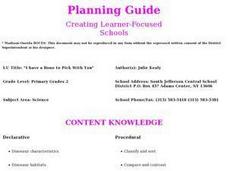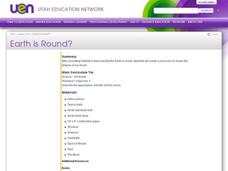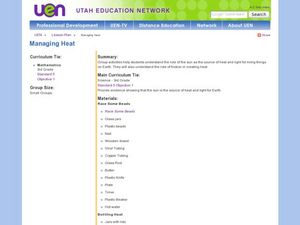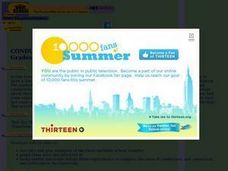Curated OER
We Are Lunar tics!
Second graders, working in cooperative groups, will create a multimedia presentation about the Earth's moon. Their research must be presented through three or more methods. (i.e. charts; graphs; oral reports; multi-media; dramatic role...
Curated OER
Introduction to the Circulatory System
Fifth graders analyze the components of the circulatory system. They take notes as they watch a video on blood and circulation. Students discuss the human circulatory system, including blood, veins, arteries, capillaries and the heart.
Curated OER
Plates on the Move
Students explore how Africa appears to be tearing apart from Asia and tha the other continents are moving and oceans are changing size.
Curated OER
And the Bacteria Ran Away with the Petri Dish
Sixth graders complete a think, pair, share activity on an antibiotic overhead. In groups, they participate in an exercise in which they can see how germs behave and how they are treated. To end the lesson, they discuss how a...
Curated OER
What You See Is What You Get
Students explore light and colors. They see how white light is made up of various colors. They need to have some background knowledge about prisms, light wave lengths, and behavior of light, primary and secondary colors, and ratios.
Curated OER
ChromaCool!
Fifth graders watch a video about physical and chemical changes. In groups, they participate in a variety of activities involving color. They write their observations in a journal. To end the lesson, they use a checklist to classify...
Curated OER
Catching Some Rays
Sixth graders explore the tilt of Earth's axis. In this Earth lesson, 6th graders read a Greek mythology story explaining why there are seasons. Students build a sun-ray gathering tool from styrofoam, glue, thermometers, skewers, and...
Curated OER
The Great Winged Adventure
Students identify characteristics of birds, name several species, and explain how birds fly. They make nests and give bird presentations.
Curated OER
Sound All Around Us
Students make predictions about how sound is formed. They view and discuss a video that explores sound formation and attempt to identify the origin of different sounds.
Curated OER
Marshland Wonders
Students review the characteristics of wetlands and list their benefits. After viewing short videos, they identify the organims that make their home in wetlands and how they have adapted. They compare and contrast the characteristics...
Curated OER
Rock Discovery
Fourth graders identify rocks in this discovery lesson by examining rock characteristics and processes. They identify basic properties of minerals and rocks. They revise their theories of the natural world, once they see and learn new...
Curated OER
What is in Soil?
Fourth graders identify and examine the components that make up soil. Individually, they use a magnifying glass to identify the organic and inorganic material in their soil sample. To end the lesson, they record the differences in the...
Curated OER
The World of Insects and Spiders
Students identify numerous insects and their body parts. In this insect life lesson, students practice using scientific vocabulary while comparing the different parts of spiders and insects. Students view several videos discussing the...
Curated OER
Weather or Not
Sixth graders explore weather. In this meteorology lesson, 6th graders create weather instruments and compare and contrast weather data.
Curated OER
I Have a Bone To Pick With You
Students explore fossils and how they are found by paleontologists.
Curated OER
To Drink or not to Drink
Seventh graders discuss water quality, water availability and water resources and how water is used in the world around them. They view a video on water quality then test for pH, temperature and dissolved oxygen to indicate water quality.
Curated OER
Around the Sun We Go
Sixth graders complete a short survey on the relationship between the Earth and the Sun. In groups, they participate in an experiment in which they test the angle of the Earth and compare it to the sun. To end the lesson, they discuss...
Curated OER
Bouncing Popcorn
Third graders meet a teacher challenge to work like chemists. They investigate with baking soda, water, salt, sugar, vinegar, and sprite to move a popcorn kernel from the bottom of a cup to the top. They experiment with different...
Curated OER
Easy Does It
Students discover how inclined planes make work easier as they make mathematical predictions and prove their predictions through experiments.
Curated OER
When Ants Fly
Here is a great lesson on constructing line graphs. Learners identify common characteristics of birds, ants common needs of all living things. They also write a story from the perspective of an ant or a bird that has lost its home and...
Curated OER
The Six Faces of Garbage
Students use the mathematics of surface area to approach the problem of garbage pollution from the classroom. After watching a video, students construct replicas of cereal boxes and compute their surface area.
Curated OER
Earth is Round?
Third graders discuss how Aristotle concluded that the Earth was round. As a class, they review theories about the Earth's shape and describe how life on Earth would be different if it were flat. Individually, they make a moon book in...
Curated OER
Managing Heat
Third graders perform various experiments to show the flow of energy that causes heat. For this heat lesson, 3rd graders understand how heat is transferred or trapped. Students use the scientific method and critical thinking skills to...
Curated OER
Conduction, Convection, Radiation, Oh My!
Young scholars draw a line graph, and use graphing as a tool to discover more about conduction, convection and radiation. They should design their own experiment using heat sensitive paper to show they explain these 3 processes.
Other popular searches
- Bill Nye the Science Guy #131
- Bill Nye the Science Guy #203
- Bill Nye the Science Guy 203
- Bill Nye the Science Guy 131

























